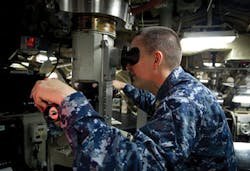Lockheed Martin to upgrade electro-optical surveillance for Navy submarines
WASHINGTON - Submarine combat systems experts at Lockheed Martin Corp. will provide systems upgrades and technology insertion for a U.S. Navy electro-optical surveillance system designed for several classes of submarines.
Officials of the Naval Sea Systems Command (NAVSEA) in Washington awarded an $119.7 million order to Lockheed Martin Mission Systems and Training in Manassas, Va., for technology insertion and refreshment for the AN/BVY-1 Integrated Submarine Imaging System (ISIS). Lockheed Martin will provide design, development, testing, reverse engineering, technology insertion and refreshment, engineering services, field engineering services, and system support for the ISIS system.
ISIS provides mission-critical, all-weather visual and electronic search, digital image management, indication, warning, and platform architecture interface capabilities for Los Angeles-, Ohio-, and Virginia-class submarines. An add-on system to integrate all imaging capabilities on existing Navy submarines, ISIS is part of the Navy's submarine Photonics Imaging System.
The ISIS program is replacing the optical light path of existing submarine periscopes with high-definition cameras and fiber-optic digital imagery. It uses infrared cameras for image enhancements; provides active and passive range finding control; installs image enhancement capabilities and analysis tools for real-time and recorded imagery; provides image recording, storage, and recall capabilities; and provides the ability to transmit imagery off the submarine to other naval and joint forces.
In-Depth Engineering Corp. in Fairfax, Va., erves as the software development lead for AN/BVY-1 ISIS, a system that revolutionizes Navy submarine surveillance capabilities by integrating digital video and still images from devices on a submarine's exterior and presenting real-time imagery and analysis on existing control room tactical displays.
Lockheed Martin will do the work in Manassas, Virginia Beach, Arlington, and Fairfax, Va.; Syracuse, N.Y.; Northampton, Mass.; and Newport, R.I., and should be finished by September 2018.
FOR MORE INFORMATION visit Lockheed Martin Rotary and Mission Systems online at www.lockheedmartin.com/us/rms.html.

